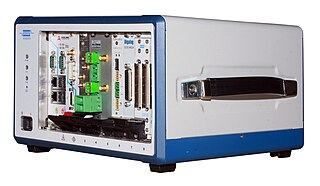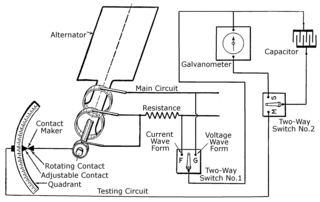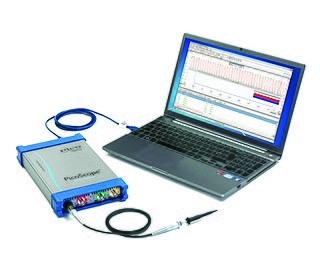Virtual instrumentation is the use of customizable software and modular measurement hardware to create user-defined measurement systems.
Virtual instrumentation is the use of customizable software and modular measurement hardware to create user-defined measurement systems.
Traditional hardware instrumentation systems are made up of fixed hardware components, such as digital multimeters and oscilloscopes that are completely specific to their stimulus, analysis, or measurement function. Because of their hard-coded function, these systems are more limited in their versatility than virtual instrumentation systems. The primary difference between hardware instrumentation and virtual instrumentation is that software is used to replace a large amount of hardware. The software enables complex and expensive hardware to be replaced by already purchased computer hardware; e. g. analog-to-digital converter can act as a hardware complement of a virtual oscilloscope, a potentiostat enables frequency response acquisition and analysis in electrochemical impedance spectroscopy with virtual instrumentation.
The concept of a synthetic instrument is a subset of the virtual instrumentation concept. A synthetic instrument is a kind of virtual instrumentation that is purely software defined. A synthetic instrument performs a specific synthesis, analysis, or measurement function on completely generic, measurement agnostic hardware. Virtual instrumentation can still have measurement-specific hardware, and tend to emphasize modular hardware approaches that facilitate this specificity. Hardware supporting synthetic instrumentation is by definition not specific to the measurement, nor is it necessarily (or usually) modular.
Leveraging commercially available technologies, such as the PC and the analog-to-digital converter, virtual instrumentation has grown significantly since its inception in the late 1970s. Additionally, software packages like National Instruments' LabVIEW and other graphical programming languages helped grow adoption by making it easier for non-programmers to develop systems.
The newly updated technology called "hard virtual instrumentation" is developed by some companies. It is said that with this technology the execution of the software is done by the hardware itself which can help in fast real time processing.[ citation needed ]

In electronics, an analog-to-digital converter is a system that converts an analog signal, such as a sound picked up by a microphone or light entering a digital camera, into a digital signal. An ADC may also provide an isolated measurement such as an electronic device that converts an analog input voltage or current to a digital number representing the magnitude of the voltage or current. Typically the digital output is a two's complement binary number that is proportional to the input, but there are other possibilities.

A logic analyzer is an electronic instrument that captures and displays multiple logic signals from a digital system or digital circuit. A logic analyzer may convert the captured data into timing diagrams, protocol decodes, state machine traces, opcodes, or may correlate opcodes with source-level software. Logic analyzers have advanced triggering capabilities, and are useful when a user needs to see the timing relationships between many signals in a digital system.

Software-defined radio (SDR) is a radio communication system where components that conventionally have been implemented in analog hardware are instead implemented by means of software on a computer or embedded system. While the concept of SDR is not new, the rapidly evolving capabilities of digital electronics render practical many processes which were once only theoretically possible.

Data acquisition is the process of sampling signals that measure real-world physical conditions and converting the resulting samples into digital numeric values that can be manipulated by a computer. Data acquisition systems, abbreviated by the acronyms DAS,DAQ, or DAU, typically convert analog waveforms into digital values for processing. The components of data acquisition systems include:

IEEE 488, also known as HP-IB and generically as GPIB, is a short-range digital communications 8-bit parallel multi-master interface bus specification developed by Hewlett-Packard. It subsequently became the subject of several standards. Although the bus was originally created to connect together automated test equipment, it also had some success as a peripheral bus for early microcomputers, notably the Commodore PET. Newer standards have largely replaced IEEE 488 for computer use, but it is still used by test equipment.

Modular synthesizers are synthesizers composed of separate modules for different functions. The modules can be connected together by the user to create a patch. The outputs from the modules may include audio signals, analog control voltages, or digital signals for logic or timing conditions. Typical modules are voltage-controlled oscillators, voltage-controlled filters, voltage-controlled amplifiers and envelope generators.

Electronic test equipment is used to create signals and capture responses from electronic devices under test (DUTs). In this way, the proper operation of the DUT can be proven or faults in the device can be traced. Use of electronic test equipment is essential to any serious work on electronics systems.

In metrology, a synthetic instrument is software that performs a specific synthesis, analysis, or measurement function. A Synthetic Measurement System (SMS) is a common, general purpose, physical hardware platform that is intended to perform many kinds of synthesis, analysis, or measurement functions using synthetic instruments.

Automatic test equipment or automated test equipment (ATE) is any apparatus that performs tests on a device, known as the device under test (DUT), equipment under test (EUT) or unit under test (UUT), using automation to quickly perform measurements and evaluate the test results. An ATE can be a simple computer-controlled digital multimeter, or a complicated system containing dozens of complex test instruments capable of automatically testing and diagnosing faults in sophisticated electronic packaged parts or on wafer testing, including system on chips and integrated circuits.

PCI eXtensions for Instrumentation (PXI) is one of several modular electronic instrumentation platforms in current use based on the Peripheral Component Interconnect bus, which includes PCI Express (PCIe). These platforms are used as a basis for building electronic test equipment, automation systems, and modular laboratory instruments.
In computer programming, instrumentation is the act of modifying software so that analysis can be performed on it.

An oscilloscope,, is a type of electronic test instrument that graphically displays varying voltages of one or more signals as a function of time. Their main purpose is capturing information on electrical signals for debugging, analysis, or characterization. The displayed waveform can then be analyzed for properties such as amplitude, frequency, rise time, time interval, distortion, and others. Originally, calculation of these values required manually measuring the waveform against the scales built into the screen of the instrument. Modern digital instruments may calculate and display these properties directly.

The National Science Foundation supported Mobile Studio Project, or Mobile Studio, is developing pedagogy and hardware/software which, when connected to a PC, provides functionality similar to that of laboratory equipment typically associated with an instrumented studio classroom. The Mobile Studio IOBoard is a small, inexpensive hardware platform for use in a home, classroom or remote environment. When coupled with the Mobile Studio Desktop software, the system duplicates a large amount of the hardware often used to teach Electrical Engineering, Computer Engineering, Control Systems, and Physics courses; among others. With the support of several technology companies and the National Science Foundation, the Mobile Studio Project is now being utilized to enhance science, math, engineering and technology education around the world. The project's goal is to enable hands-on exploration of science and engineering principles, devices, and systems that have historically been restricted to expensive laboratory facilities.
A digital pattern generator is a piece of electronic test equipment or software used to generate digital electronic stimuli. Digital electronics stimuli are a specific kind of electrical waveform varying between two conventional voltages that correspond to two logic states. The main purpose of a digital pattern generator is to stimulate the inputs of a digital electronic device. For that reason, the voltage levels generated by a digital pattern generator are often compatible with digital electronics I/O standards – TTL, LVTTL, LVCMOS and LVDS, for instance.
This is a subdivision of the Oscilloscope article, discussing the various types and models of oscilloscopes in greater detail.

The history of the oscilloscope was fundamental to science because an oscilloscope is a device for viewing waveform oscillations, as of electrical voltage or current, in order to measure frequency and other wave characteristics. This was important in developing electromagnetic theory. The first recordings of waveforms were with a galvanometer coupled to a mechanical drawing system dating from the second decade of the 19th century. The modern day digital oscilloscope is a consequence of multiple generations of development of the oscillograph, cathode-ray tubes, analog oscilloscopes, and digital electronics.

A digital storage oscilloscope (DSO) is an oscilloscope which stores and analyses the input signal digitally rather than using analog techniques. It is now the most common type of oscilloscope in use because of the advanced trigger, storage, display and measurement features which it typically provides.

CompactDAQ is a data acquisition platform built by National Instruments that includes a broad set of compatible hardware and software. CompactDAQ integrates hardware for data I/O with LabVIEW software to enable engineers to collect, process and analyse sensor data. CompactDAQ systems are less expensive than equivalent systems within the NI PXI Platform.

Pico Technology is a British manufacturer of high-precision PC-based oscilloscopes and automotive diagnostics equipment, founded in 1991. Their product range includes the PicoScope line of PC-based oscilloscopes, data loggers, automotive equipment, and most recently, handheld USB-based oscilloscopes. Since their inception in 1991, Pico Tech has been researching and developing PC-based oscilloscopes, when the market standard was analogue storage oscilloscopes. Pico Technology is one of two European scope manufacturers, and competes in the low to middle end of the instrumentation market.

PicoScope is computer software for real-time signal acquisition of Pico Technology oscilloscopes. PicoScope is supported on Microsoft Windows, Mac OS X, Debian and Ubuntu platforms. PicoScope is primarily used to view and analyze real-time signals from PicoScope oscilloscopes and data loggers. PicoScope software enables analysis using FFT, a spectrum analyser, voltage-based triggers, and the ability to save/load waveforms to disk. PicoScope is compatible with parallel port oscilloscopes and the newer USB oscilloscopes.